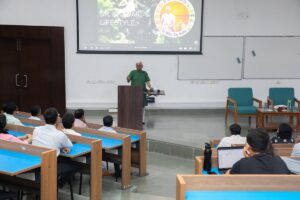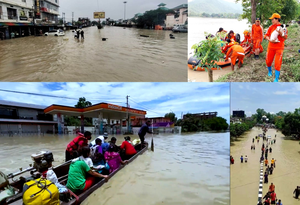“Increased use of rice, wheat, and sugar has given birth to diseases” says Millet Man Dr Khader Vali at IITGN
Millets are best for human health, soil and environment
“Reintroducing millets as our staple diet can contribute hugely in reducing environmental impact and ensuring food security. The same huge amount of water used for growing only one kg of rice can grow about 30 kgs of kodo millet. Moreover, each kg of millet can feed ten people, while one kg of rice can feed only five people” – Dr Khader Vali
BILKULONLINE
Gandhinagar, Nov 1: Joining forces to celebrate 2023 as the International Year of Millets as declared by the United Nations following an appeal by the Government of India to create awareness about the benefits of production and consumption of millets, the Indian Institute of Technology Gandhinagar (IITGN) organised a talk by Dr Khader Vali, popularly known as “the Millet Man of India”, on October 31, 2023.
Dr Khader Vali, a scientist, food expert, and recipient of the prestigious Padma Shri and Krushiratna awards, has revived five varieties of disappearing millets and has been working for more than 20 years to bring back diversity in food grains for a healthy and disease-free life. During his talk titled “Discovering the Millet Way to Good Health”, Dr Khader Vali condemned the corporatisation of farming and the healthcare industry and the increased use of wheat, rice, and sugar that has given birth to all kinds of modern diseases. He said, “It is kind of ironic that in the name of patents, the seeds and rights of seeds of farmers worldwide have been taken away, and we keep seeing the so-called intellectuals participate in discussions about food security. Also, the food we are eating is not our real food. The majority of our food these days is made of rice, wheat, and sugar, which disturbs the concentration of glucose in our bodies, which I call ‘glucose imbalance’, thickens our blood, and affects the heart and, subsequently, all the organs. And yet, no questions are asked anywhere in the world regarding its ill effects on human health and exponential growth of modern diseases.”

Introducing the audience to the science of millets, Dr Vali said, “Humans used to eat various kinds of grains/millets available in their vicinity for thousands of years, which used to grow through seeds of more than 800 types of grasses grown even in less fertile lands. And still, they were much stronger and healthier. The grasses of millets can absorb water directly from the atmosphere, and they need very less amount of water for irrigation for survival, unlike wheat, rice, and sugarcane, which require huge amounts of water for irrigation through dams or underground water pumping, further adding to the carbon footprints. This way, about 80 percent of our less fertile lands can also be used for farming. The same amount of millet, in comparison with rice or wheat, can also feed more people. Hence, reintroducing millets as our staple diet can contribute hugely to reducing environmental impact and ensuring food security.”
He gave an example of ‘Kodo Millet/Rice’; one kg of this millet can be grown with only 150 litres of water, whereas growing one kg of rice consumes about 8000 litres of water. This same huge amount of water can produce about 30 kgs of kodo rice. Moreover, each kg of millet can feed ten people, while one kg of rice can feed only five. “Nature is the kitchen of the earth. So we need to partake in the diversified food that is available as per different kinds of lands. Millets and their grasses are genetically able to grow in large quantities with the least external inputs. On the contrary, you cannot grow large quantities of rice and wheat naturally or without external inputs of additional water and fertilisers because their genomic content is smaller, and such practices are further deteriorating our health and environment. Sustainable food practices have been wiped out by such crops because of their corporatisation”, he added.
Elaborating on the health aspects of millets, Dr Khader Vali said, “Till rice and wheat came in our plates on a daily basis, no one had diseases like high blood pressure, diabetes, arthritis, thyroid, fatty liver, and so on because they make our blood thicker to reach all organs efficiently. Milk is also not needed by all the people all the time. Sugar is the most harmful to our bodies, and we shouldn’t have even a milligram of it. Many modern/lifestyle diseases that have increased over time are the results of the food choices we made in the last 100 years and the unnecessary use of medicines. These diseases were not there earlier because humans ate millets, which keeps our blood thin so that it reaches easily in all organs of the body; its rich natural fibre contents help our mitochondria burn unnecessary glucose; and ultimately, our gut microbes provide more immunity against infections. For a healthy body, the detox has to happen on a daily basis for each and every cell. And so, millets become a wonderful weapon in your blood to wipe out all kinds of diseases.”
In his concluding remarks, Dr Vali underlined, “If your food is right, no medicines are needed. If your food is wrong, no medicines will work. And the right food is millets.”
IITGN has also been promoting the use of millets in its mess menu in different ways. The Institute has already organised various competitions like slogan-writing and poster-making competitions to raise awareness among students about the advantages of millet and its many nutrients.




